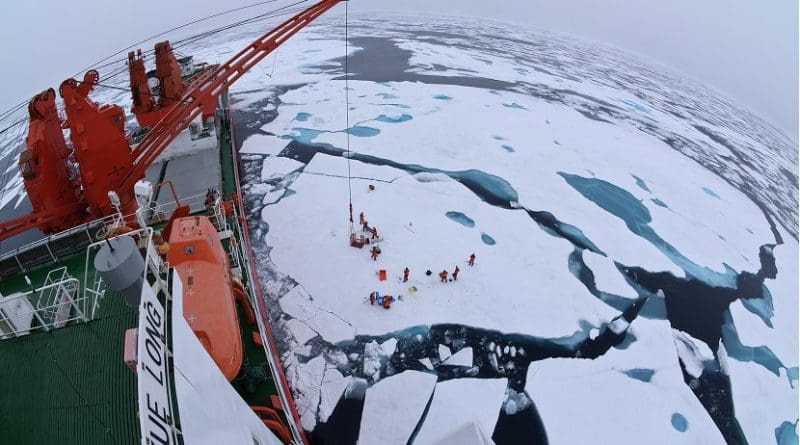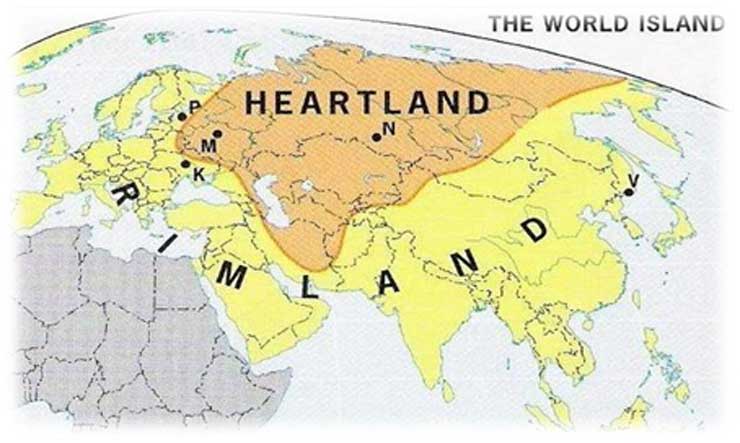Ice Silk Road: From Dream To Reality – Analysis
By Mahdi Torabi and Vahid Pourtajrishi*
The history of Silk Road backs to thousands years ago. The aim of creation of this route was linking China to Europe through Middle East. Growth of Chinese enterprises and industries which was started since middle of 20th century increased the significance of expanding the link routes between China and Europe following expansion of China’s export to West. Silk Road seems to be the main option in such condition as an ancient route which has been designed and created for this purpose.
But the main existing problem on this way was existinglimitation on capability of the classic Silk Road for transportation of high volume of freight from China to Europe.
In fact, the issue of increase this capability was the essence of Xi Jinping’s initiation of his “One Road One Belt” Doctrine which was declared by him as one of the significant elements of Chinese foreign policy.
According to the Xi Jinping’s defined policy for the new Silk Road, this route has to be expanded to some new routes on the ground and sea. But it has to be mentioned that China has not been the only state who follows Jinping’s policy toward Silk Road. Many of other states, especially those who are located on China – Europe rote try to increase role on this high interesting route.
Through these states, we can point to Turkey and Russia as the most important ones who have shown their will to participate highly in this project.
Turkey introduced its Baku – Tbilisi – Kars (BTK) Corridor to create a new Silk Road which connects Istanbul to China by passing Azerbaijan and Kazakhstan. Ankara’s initiation in introducing a new combined route was a revolution in the regional and intercontinental transport orders.
But beside of all defined merits for this route, some disadvantages like high cost of transport or existence of not suitable weather conditions for move of ships through Caspian Sea on winter. That’s why;relating released reports on establishment of BTK by Turkey and its partners created a shock among experts in international transportation.
While many of experts recognized this route as the last alternative for the classic Silk Road, Russia could come over its geographical problems with sea ices of Arctic to establish Northern Sea Route or Ice Silk Road which was just an inaccessible dream for Moscow till few years ago.
Passing through Arctic that is fully covered with at least 150cm diameter pieces of ice might was just like a joke or far dream before end of Cold War and there was no strong logic behind of such assumption.
By start of the Cold War and fast growth of the nuclear technology in 60s to 90s, we can say that development of many nuclear related technologies like construction of reactors, enrichment and producing nuclear armament in one hand andexpansion of maritime industries especially in military section got in force by USSR.
But the main reasons for focus of Moscow on Arctic back to significance of natural resources in this region which composed determinants and important part of USSR’s boundaries.
While latitude of Scandinavian states and Canada is closed to Arctic, but no one of these states has not been successful enough to use the potential opportunities of this region like Russia.
Since Vladimir Putin’s seize of power in 2000 and his plans for reconstruction of Russia’s economy, discover of new routes to access world markets was adopted on the agenda of the Russian government. Finding new costumers for the huge resources of oil and gas was one of the main attitudes of Russia in Moscow’s new economic planning. That’s why Russia began to expand and execution of its significant and mega plans in this regard like establishment of Turkish Stream gas pipeline.
Despite all adopted policy by Russian government, the main problem was Makinder’s concern in his theory of “Heartland” to access the warm water. According to Makinder, the only available link route between Russia and the southern warm water was Iran. That’s why; Russians always have been looking for a way to access free and warm waters by Iran.
But by achieved impressive growth of technology during past decades, it seems Russia has found a safer way to access free waters instead of Iran and that is use of its territorial waters of Arctic that is able to link this country to Europe on one hand and connects Russia to East and China from on the other hand.
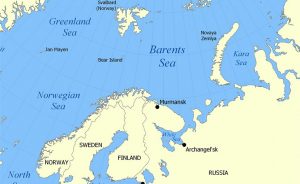
As we know, required technology for using the Northern Sea in international transit of freight have always been in hands of Russia and US. But this route has never been as interesting one for US because of its easy access to the free waters on one hand and end of Cold War on the other hand. That’s why there has been not enough interest for US to invest much in expansion of international transit route from Arctic region. US has only one icebreaker in North Sea and Arctic that is built in 1976 and was used for costal patrol in this region during Cold War era.
We try to investigate the probable causes for establishment of the “Ice Silk Road” by Russia in the following:
Expansion of the oil fields of Arctic and oil export increase
Russia got succeedto transport its first oil cargo in 2017 from Hammerfest in Norway into BoryeongPort of South Korea successfully. This shipment was a 200 million dollars LNG cargo which was transported by “Cristophe de Margerie” tanker carrier within just 19 days. It means Russia got succeed to save the time for 30% rather using Suez Canal as the common path of this route.
Russia has invested in development and expansion of the gas field of “YamalPeninsula” more than 27 million dollars and China also has announced its readiness for investment in this mega project. It is worth mentioning that the order of development this project issued by Vladimir Putinpersonally and this demonstrates the level of priority and significance of this project for Moscow. Margarie ice breaker tanker could sliced the huge ices of Arctic with at least 120 cm thickness and passed Arctic within just six days. But it is clear that possibility of such shipment will get very harder during winter season and needs high-developed ice breakers. That’s why, Russia has decided to produce new generation of these ice breakers to remove this obstacle.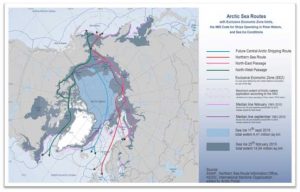
Following this policy, Dimitry Rogozin, the deputy of the Russia’s prime minister in his interview with TASS News Agency declared decision of his country to build three new nuclear ice breakers. He said: “Rosatom [state civilian nuclear power corporation] has now been instructed as part of private and state partnership to think over the algorithm of financing three icebreakers rather than one and then we will make navigable the entire Northern Sea Route. We will be able to lead whatever vessels for any customer by transit through the Northern Sea Route: caravans with goods from Asia to Europe and we will be able to export our hydrocarbons in the form of liquefied natural gas not only to Europe but also to Southeast Asia,” Rogozin said in an interview with Rossiya-24 TV Channel, describing the plans of developing Russia’s icebreaker fleet.
“In 2019, we will commission [the shipyard’s] dry dock. Just imagine the dimensions: 484 meters long and 114 meters wide. Two aircraft carriers can be built there at a time,” the vice-premier said, describing the new shipyard.
Simultaneously, shipbuilders in northwest Russia are building three current-generation icebreakers: the Arktika, the Ural and the Sibir, Rogozin said.
Simultaneously, shipbuilders in northwest Russia are building three current-generation icebreakers: the Arktika, the Ural and the Sibir, Rogozin said.
According to the vice-premier, these icebreakers will be commissioned for operation in 2019-2021 and “will help ensure an all-out escort [of vessels] through the ice from Yamal Peninsula towards the West.”
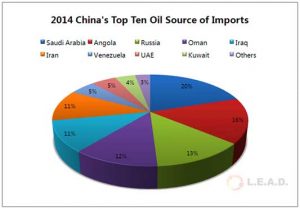 “Yamal LNG Project” is under construction in Yamal Peninsula and is counted as the most significant maritime project of Russia in energy sector. This mega project includes 200 wells, one airport and 15 tankers (2016) which will be able to export at least 2 million cm liquid gas. According to experts, this amount will be increased to 50 million cm in a year (the Ministry of Roads and Urban development of Iran).
“Yamal LNG Project” is under construction in Yamal Peninsula and is counted as the most significant maritime project of Russia in energy sector. This mega project includes 200 wells, one airport and 15 tankers (2016) which will be able to export at least 2 million cm liquid gas. According to experts, this amount will be increased to 50 million cm in a year (the Ministry of Roads and Urban development of Iran).
On the other hand, China is one of the most important strategic customers and trade partners of Russia especially in oil section. According to the experts and analysts of energy section, China will be the consumer of 17% of energy resources of the world till 2050. That’s why, if Russia increases the amount of its oil productions, Moscow would become the first oil partner of China instead of the Middle Eastern oil exporters like Saudi Arabia, UAE and Iran.
Transit of freight from China to West (the Ice Silk Road)
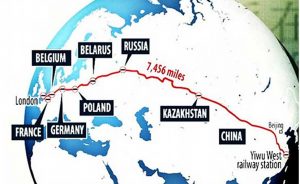 According to Dimitry Rogozin, transit of freight from Far East to West using Arctic and Northern Sea will be one the main aims of Russia to establish the North Sea Route. Export of the Russian productions into South East of Asia is one of the other significant aims of creating such route. As Rogozin declared, the new generation of the nuclear ice breakers will be able to carry two aircraft carriers. So the approximate area of the each mentioned freight carrier will be something around 55176 m2 and this dimension will be more than 5.5 hectares!
According to Dimitry Rogozin, transit of freight from Far East to West using Arctic and Northern Sea will be one the main aims of Russia to establish the North Sea Route. Export of the Russian productions into South East of Asia is one of the other significant aims of creating such route. As Rogozin declared, the new generation of the nuclear ice breakers will be able to carry two aircraft carriers. So the approximate area of the each mentioned freight carrier will be something around 55176 m2 and this dimension will be more than 5.5 hectares!
Furthermore, creation of the new route will be 25-55 percent shorter than the Suez Canal path which links China to Europe to each other.
It is worth to mention that one of the significant exports of Russia from this route will be the mineral extractions like gold, uranium and diamondin worth of more than five billion dollars.
Reduction of China’s dependence on Middle Eastern oil
China is one of the key players and investors in Yamal project and has invested more than 12 million dollars in this mega project. Except this, the Silk Road Fund has fulfilled 20% of the total project cost. But it has to be asked why China follows this project while Beijing fulfills its required oil from Middle East?
In fact, the energy market of Middle East and its stability is under doubt because of existing many problematic factors like anti – Iranian sanction, fire of war all over the region, the issue of illegal immigration of terrorist groups and etc. that’s why such market could not be counted as a stable and permanent energy market for China as the greatest industrial country of world.
So, it seems the Chinese officials have decided to find a more stable alternative to fulfill its energy needs instead of Middle East. On the other hand, we cannot ignore the existing strategic partnership between China and Russia in this way. Also, by creation of Ice Silk Road, it will be more logical for China to fulfill its required energy resources from Russia regarding the issue of short geographical distance between the two countries rather Middle East.
A the end, we have to say that creation of Ice Silk Road is minded as a game changer not only in foreign trade relations of Russia but also will be a revolution in international trade between East and West especially in aspect of trade corridors. It could affect highly on the both classic and new routes in Silk Road like the passing corridors from Iran, Turkey, Azerbaijan and many other states that have enjoyed their geo-economics privileges on this route.
*About the authors:
*Mahdi Torabi is head of planning unit at department of the international affairs of the Railway of the Islamic Republic of Iran.
Vahid Pourtajrishi is an expert at planning unit of the department of the international affairs of the Railways of the Islamic Republic of Iran. He has worked as journalist at correspondent of Mehr News Agency.
Source:
This article was published by Modern Diplomacy.

